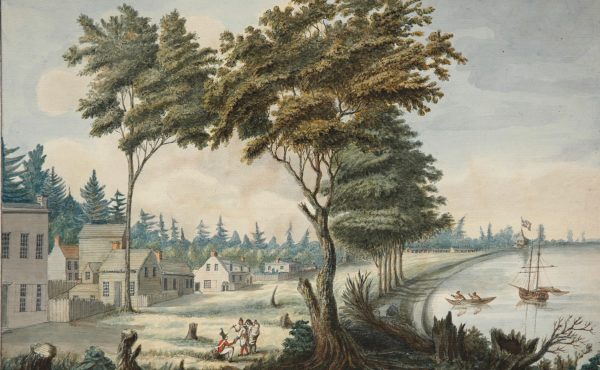
Andy Reeves will be covering ad creep and streetscape issues during the 2006 election for the Spacing Votes blog. Here’s a report by Reeves from his recent travels out west.
– – – – – – – – – – – – – – – – – – – – – – – – – – – – – – – – – – – – – – – – – – – – – – – – – – – – –
Travelling out from Toronto for the first time to Canada’s west coast allowed me to see how Toronto relates to its big-city Canadian counterparts. And taking public space as an example, and the ways in which the city attempts to regulate public space, we can see where Toronto sits on the national streetscape radar.
VANCOUVER & VICTORIA
I arrived in Vancouver inundated with the hype from my friends about the West Coast Way Of Life: those easy-going, highly liberalized nuances that make life in Vancouver — depending on which neighbourhood you call home — a little more relaxed and free-wheelin’. Aside from the entertaining tourist traps, it was interesting to see the subtle ways in which the cities of Vancouver and Victoria allow for a rather large range of expression and experimentation with their public spaces.
Here are a few examples:
Solar Trash Compactor/Bins
While Spacing covered trash compactors in Boston at the beginning of August, I was surprised to see one — and I stress, I only did ever see one — of these contraptions in the downtown core of Vancouver. It was in a rather out-of-the-way location, but the old man who passed us didn’t seem to find its presence so strange. I was confused as to why there were not more of them, in more high-traffic areas. The idea, however, doesn’t seem to have caught on across the Straight on the Island, as Victoria, the province’s capital, still relies on basic trash bins with a smattering of recycle containers to handle the scores of tourists trash. Score one for Toronto.
Utility Boxes
 Both Vancouver and Victoria have utilized utility boxes in different, but equally interesting ways. Vancouver has decorated its utility boxes with images from the city’s past (similar to Winnipeg); heritage buildings and historic urban photographs adorn these otherwise dull and easily vandalized hydro boxes with pictures of the way the city used to look at any given time and place. In Victoria, the city has understood the importance of tourism to its economy and plastered wrap-around maps of the city on its utility boxes (image right). They all feature different ‘You Are Here’ indicators to let tourists know which of the two main streets they are on. Chances are, if you’re not on Douglas, you’re on Government.
Both Vancouver and Victoria have utilized utility boxes in different, but equally interesting ways. Vancouver has decorated its utility boxes with images from the city’s past (similar to Winnipeg); heritage buildings and historic urban photographs adorn these otherwise dull and easily vandalized hydro boxes with pictures of the way the city used to look at any given time and place. In Victoria, the city has understood the importance of tourism to its economy and plastered wrap-around maps of the city on its utility boxes (image right). They all feature different ‘You Are Here’ indicators to let tourists know which of the two main streets they are on. Chances are, if you’re not on Douglas, you’re on Government.
Green Spaces
I’ll touch on the importance that Vancouver, and to a lesser extent, Victoria, have given to both public and green spaces in their respective cities. So much has been said about the importance of Stanley Park to the beauty of Vancouver that I wont dwell on it. But I will say that coming from Toronto, where anyone living in the downtown core like myself must travel a considerable distance to reach a public park of any substantial size and worth — by this I mean trees, old ones, and water, perhaps wildlife of some sort (squirrels don’t count) — it was so incredibly uplifting to see that something as simple and beautiful as a public park could find a place at the centre of a city. The people of Vancouver love Stanley Park, and demonstrate that love by how clean it is, and by the sheer volume of their presence in the park each and every day. Weather permitting.
Open Spaces
Tourism is a relentless industry, and a tiring habit. I sat down to rest one afternoon in Robson Square, across from the Vancouver Art Gallery, a former provincial Court House, and an imposing old building. Going down the steps to a bench I heard the sounds of beat music coming from a crappy old boom-box. The square, which is normally a shortcut for students getting from the mall underground to the UBC downtown bookstore, was handed over to practicing breakdancers. That very night, the same square was crawling with bumping hips and latin music as the middle-aged of Vancouver came out to learn how to salsa. The place was packed! But that afternoon, as I looked around in Robson Square from the breakdancers, to the punks and mid-day homeless sitting on the steps of the Art Gallery, to the single hot dog vendor I saw the entire time and the gaggles of late-summer teens soaking it up before school began again, I noticed that I did not see a single commercial advertisement. The feeling of being in a city — a living, smelly, noisy city — rather than a petri dish for billboards and commercial space, was something I had never felt before. And something I imagine few of us can, or will ever feel at Toronto’s downtown equivalent at Yonge and Dundas.
None of this is to say that Vancouver or Victoria is a better place to live than Toronto. Cities exist and flourish when they learn from each other, and observe the brilliant plans and awful follies by seeing it test-run in the other major hubs of our society.
— Andy Reeves




2 comments
There are two Stanley Parks, one in the daytime and one at night and never should a person get confused as to which they should be atttending. I find the “easy-going, highly liberalized nuances” thing to be a bit of a myth and find Vancouver to often be as uptight, overpriced and traffic clogged as Toronto.sd
I was just out in Vancouver and Victoria as well, and did a bit of my own urban research/touristing.
The waste management comparison between TO and Vancouver is interesting, but Andy doesn’t seem to have noted the important differences.
Vancouver and Victoria (and perhaps all of BC) have a packagaging-return system in addition to what seems to be a more conventional recycling program.
People take their recyclables to an Encorp (www.encorp.ca) return-it centre and get money back, depending on the value of the items they return.
And it appears that this system creates a whole slew of new opportunities for managing waste in public areas. In Granville Island (a big tourist area, and food and art market) there were bins collecting bottles for the Salvation Army. Downtown in the midst of the new condo developments, garbage bins have places outside the bin for bottles, to make it easier for bottle collectors (collecting for personal income) to find them.
These bins are obviously designed as a response to the packaging-return system. This illustrates the relationship that exists between street furniture and policy…if similar policy changes happen in Toronto, I wonder if a harmonized street furniture program would serve to impede the design street furniture that would respond to changes in the way we manage our city…
Interestingly, Vancouver has no city-wide composting program, but residential composters seem a bit more common than in TO pre-green bin, and there are private companies that can be hired to pick up commercial compost.
Of course there are all sorts of issues connected to this system as well (like encouraging the use of disposable/recyclable containers, and even making it a potentially charitable act, and the failure to accommodate paper recycling in public places), but it definitely qualifies as a significant alternative to the way we do things here in Toronto.
As for Vancouver’s green spaces, while Stanley Park is indeed wonderful, the city is remarkably more “green” overall than Toronto. Beyond the fact that Vancouver has a dizzying number of waterfronts thanks to the geography of the city (many of them complete with public parks, beaches and/or pedestrian and cycling paths) the city has an abundance of trees, plants and gardens just about everywhere (residential areas, strip malls, box malls, city streets, commercial areas), giving the city a much different feel than the concrete-as-far-as-the-eye-can-see-ness of downtown Toronto. This focus on landscaping was so significant that I wonder if this is due to different by-laws and building requirements. The city is also quite hilly, which also gives the city a much different appearance from Toronto.
And just a note about the lack of ads in public spaces in Vancouver: Vancouver has much stricter by-laws concerning ads in public spaces than Toronto has (or at least if they aren’t more strict, theirs are actually enforced). Interestingly, my cousin, a marketing exec in Vancouver, complained about the by-laws, arguing that it limited possibilities for creating imaginative/creative advertising. I think Toronto proves that relaxing the by-laws does not necessarily produce more creative ads, but more creative ways to evade the by-laws.
I also took a lot of pictures and movies of the condo boom in Vancouver’s downtown core. It seemed incredibly more dense and intensive than anything I’ve seen in Toronto. Perhaps I’ll post some of that material in the future…